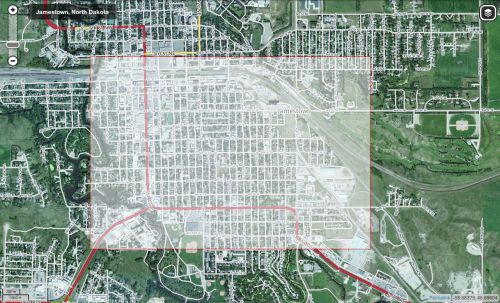Map Editor Layout
There are three main areas of the Map Editor:
- Toolbar
- Tabs Area
- Map Display Area
- At the top, a toolbar with a search box, and buttons to Add, Save, Undo, Redo, and Delete
- At the left is a Tabs Area where information is shown or made available to edit in one or more tabs
- When there are no objects selected on the map (Map Problems and Update Requests are not considered map objects)
- At the bottom of the left area are some important links for all editors to know, such as the Map Editing wiki start page, the Waze Map Editor forum, current Waze status website and keyboard shortcuts link. (Shortcut key: ?)
- Me displays your wazername, permissions level and current points, a link to the map editing video and editing manual
- Drives displays an historical archive the drives you taken with Waze running on your smartphone
- Areas shows a list of areas you are allowed to make edits within
- Me displays your wazername, permissions level and current points, a link to the map editing video and editing manual
- When a segment is selected
- General allows updating the segment attributes such as road type, direction, level, toll road, and locked and other segment details. In "Edit Mode," the General tab also displays and allowed editing of country, state in the US, city, and segment name. This is also where you can manage any alternate names (linked streets).
- At the top of the main display area below the toolbar, is a wide area which displays:
- To the left will be the current city and state (US), or Country (outside North America).
- To the right is a loading indicator which appears only when map elements are still loading.
- In the top-right corder of the main window, inside the main window space, is the activator for the layers menu.
- The map display area, which takes up the majority of the space is explained in more detail below in the Map Display Area section.
Map Editor Tool Bar
At the top of the Waze Map Editor you will see the main tool bar. It includes the primary control buttons for the editor.
Search box
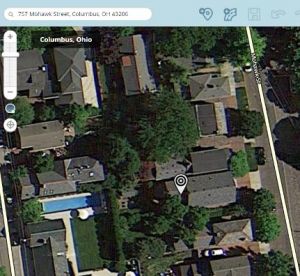
In the wide search box, you can enter an address, city, state, country, landmark, point of interest, or a combination of those. After hitting Enter or clicking the Find button, you will either be taken to the only result, or be given a list of matches from which to select.
For example, entering "757 Mohawk St, Columbus, OH" will center the map and drop a search marker directly on that address.
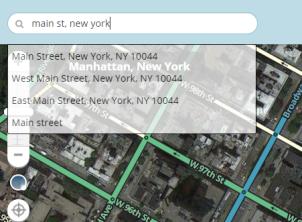
However, searching for "main st, new york" is less specific and will therefore give you a list of matches from which to select.
Add Button

Shortcut keys: i, o, g, p or u
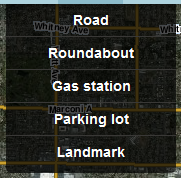
The Add Button is not really a button, but a menu. You do not need to click on it; just hover your mouse over it and the menu of objects you can add will appear below. Alternately you can use the shortcut keys for each one:
- r - Road
- o - Roundabout (think circle = O)
- g - Gas station (specific landmark)
- P - Parking lot (specific landmark)
- u - Landmark (default landmark type)
Details for each of these actions are found in the Editing Manual under their name.
Save Button

The Save button serves two purposes: 1) it displays the current number of changes pending to be saved, and 2) when clicked, it saves all the current changes you have made.
As you make changes, the counter in the Save button increases. Once you have more than 9 changes pending, the text in the icon changes to red as a warning that many unsaved changes may be difficult to save if there is a single error among the changes.
When the button is clicked (or the shortcut key used), the editor saves all of the current changes you have made. This process is a little more complex than this sounds, but that is what it does. In order to save properly, your browser receives messages back from the Waze server in the event of any errors. If there is an error when saving, the editor will try to give you a detailed error message and a suggestion to fix it. The map view will typically try to show the error area highlighted in a bright circle.
Once the save operation completes successfully, you cannot Undo previous changes with the Undo button.
Undo Button

Shortcut key: Ctrl+z
The Undo button will undo unsaved successive previous changes with each click. IMPORTANT: Once the Save button is clicked and the save operation is complete, the Undo button has no effect on previous changes.
A change can be deleting a geometry node from a segment or renaming a landmark. It can also be a change to multiple objects at once. For example, if you multi-select 25 street segments to change them from No Entrance to 2-way, that is considered a single change. Therefore, one click on Undo will undo that change for all 25 segments.
Redo Button

Shortcut key: Ctrl+Shift+z
The Redo button will re-apply any changes which have been recently undone with the Undo button.
Delete Button

Shortcut key: Delete (Del)
The Delete button will delete, or trash, any currently selected objects. If you have multiple objects selected, you will be prompted to confirm the multiple deletion. The only object you can currently multi-select is segments.
Undo does work for deleted objects. Objects are not actually deleted until the Save button is clicked. After that, you cannot Undo any edits or deletes.
Tabs Area
At the left side of the window, below your username, is an area which is both informational and functional. Depending on whether an object is selected, the type of object and how many, different tabs will be available which allow you to view and edit details.
Tabs with No object selected
 |
 |
When no objects are selected on the map, the Tabs Area displays user information. The top section greets you by name and is always visible regardless of what is showing or displayed on the map. Map Problems and Update Requests are not considered map objects, so the tabs below your name will display when a Map Problem or Update Request is selected.
Me Tab
The Me tab displays your map editing permission level and current points for the server on which you are editing (North America or World).
A Wazer with a hard hat displays if you have editing permissions. To the right of that icon will be a highlighted cone with a number. This number is your editing rank. Below those graphics is a sentence about your editing rank and permissions.
Below your user information is a box graphic which when clicked, will open up a boxed panel leading to seven videos from Waze. The videos are titled as follows:
- Introduction
- Before You Start
- Getting Started
- Basic Terms
- Basic Editing
- Map Problems
- Examples
This animated guide is a good way to get an overview of the Waze map editing system and some of the processes. These videos are only an introduction, and the information contained in the Waze wiki documentation is where you will find the most detail on the editor and, importantly, guidelines for mapping standards.
Drives Tab
The Drives tab enables you to see the history of routes you've driven with Waze running. Clicking on an entry will center the map along your route and will zoom out to try and fit your entire route on the screen. Routes over 20 miles will usually not fit on the map display all at once due to scale limitations. Parts of the route that display in red are not currently paved roads. Consider zooming into that area to determine if a road should be added.
Areas Tab
This list is of the various defined areas of which can perform edits. This is known as your editable area.
Tabs when segment(s) are selected
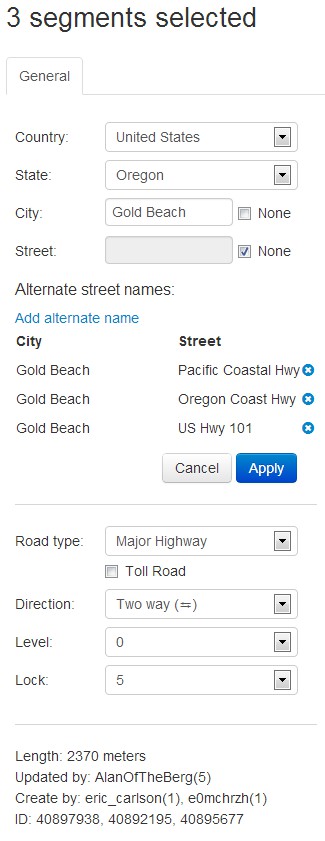
The area above the tabs will show how many segments are selected. The example graphic to the right shows what the Tabs Area looks like when multiple segments are selected and the General tab is in "Edit mode."
General Tab
The General tab displays the segment name and alternate names details at the top. Just below that information is an Edit button. More info on that below. On this tab, you can modify the road type, toll road checkbox, direction, level, and lock checkbox. Further down past a seperator line is more general details about the segment(s) which is/are selected.
Segment Edit Detail
When you click on the Edit button, or tap shortcut key 'e', the General tab changes, displaying more detail information and allows you to make changes to the country, state (US only), city and segment name. Next is where you can add or remove any alternate street name information. An alternate name, technically referred to as a "linked street," is used to capture detail such as the state or US route name of a street as it goes through an urban area where it is commonly referred to with a local name. The local name would be put into the primary name field, but the highway name can be entered as an alternate name. An alternate name street must also have the same city as the primary segment.
Select Entire Street
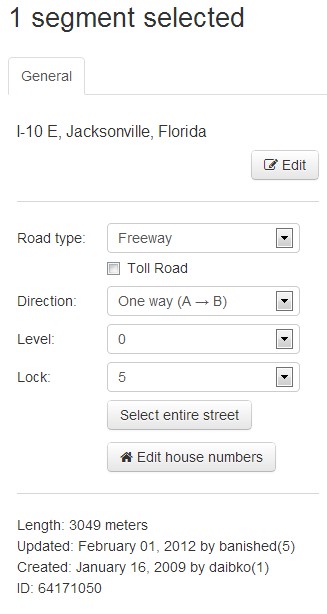
When you click the button titled "Select Entire Street," or use the keyboard shortcut Ctrl+a the editor will select all segments connected to the current segment with the same name, city, state, country information. It will also select some segments off the current visible area.
Edit House Numbers
When you click the button titled Edit House Numbers, or use the keyboard shortcut 'h', Waze enters the House Number editing interface.
TAKE NOTICE:
- The Edit House Numbers button appears when there is only one segment selected.
- The Edit House Numbers button isn't available to click when there are changes which need to be saved. The message, "Save your changes to edit house numbers" appears below the button.
Tabs when a Camera is selected
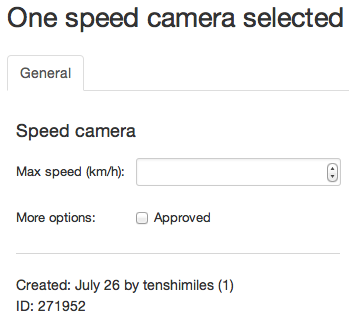
When a camera is selected, there is a single General tab which allows you to set the alert speed for a Speed Camera, and also to approve the camera once it is placed in the correct location. Red Light Cameras only need to be placed and approved and have no speed set.
Tabs when a landmark is selected
Tabs when a Gas Station is selected
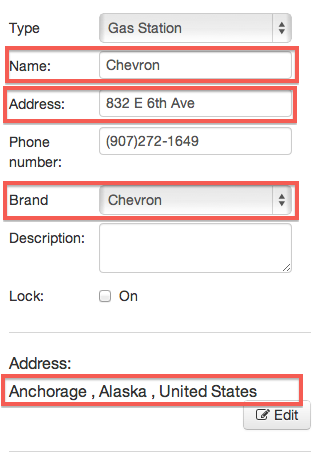
When a gas or petrol station landmark is selected, the view is very similar to that of a generic landmark. There are some more fields of data which need to be filled in or verified as part of the Gas Stations functionality in Waze.
For the Waze application to be as useful as possible to drivers, it is important to ensure all fields of information are fully and properly completed. For more details about completing this data, please see the Gas Stations page.
Map Display Area
All the layers currently selected for display show up in the map display area. The map display areas takes up the majority of the browser window. Any object displayed is selectable and editable, depending on your editing rights in the area you are viewing. Select a street and change its geometry. Select a landmark and change its name. Add a road where one should be, or delete a road which should no longer appear.
There are six main component controls or displays in the corners of the map display area:
- Info Bar
- Layers
- Zoom Control
- Scale
- Lat/Lon
- Permalink
Info bar
Just below the main toolbar, there wide area which runs the width of the map display area.
- The left side will display the current city and state (US) or city and country (world).
- The right side displays whether the editor is still loading any layers, such as road images or GPS points.
Layers

On the right-side of the main window, you will see this small icon:
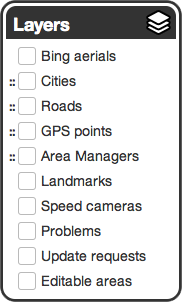
When clicked, it expands to display the layers or object types which are available for display on the main map. When the box next to the layer name is checked, then that layer is active and being displayed. There is a default shortcut key defined for each layer, and to make it easy to remember, the shortcut is Shift+<first letter of layer name>.
The four small dots to the left of a layer selector box is a drag handle which allow you to rearrange layers order. That is, which will appear on top of the other. PLEASE NOTE: The layer order is reversed from what we would normally expect. Layers at the bottom of the list are on top of the layers above.
Each of the layers is discussed in more detail later, but a short description of each is directly below.
Bing Aerials
Waze uses aerial and satellite photography provided by Bing (or VirtualEarth).
Cities
City boundaries as defined by segments assigned to that city are shown in different colors. This layer is helpful in finding segments which are set to the wrong city. Until an area is heavily edited an updated, some city boundaries are likely to be overlapping or appear to be unassociated with any segments.
Roads
Roads are all of the streets, alleys, highways, and freeways which make up the driveable street system in Waze. Depending on the zoom level, some street types are not displayed so that the map is not too cluttered.
GPS points
This layer will show tracks from Waze users as they drive with Waze running. Waze records and plots the GPS coordinate of drivers. This layer is useful for relatively accurate placement of new or moved roads when aerial photography is not yet updated. GPS points appear in the map editor as colored arrows. The direction of travel for a GPS point determine its color, so that all drivers going the same direction will show their points in the same color. This makes it easier to determine errant GPS points, or where a road on the map doesn't follow the actual path of vehicles.
Area Managers
The Area Managers layer shows overlapping colored, named rectangles. These areas represent the areas those users have Area Manager permissions. This layer allows you to identify a user you may wish to send a PM in the forums about a specific issue you noticed in their area, but do not have rights to fix.
Landmarks
Landmarks are also known as POIs (Points of Interest). These can really be just about anything, but tend to be things like parks, gas stations, cemeteries, transit stations, etc. Landmarks appear in the map editor as colored shapes.
(Speed) Cameras
Speed cameras, red-light cameras and dummy cameras are shown on this layer. Drivers report camera location and type, and a map editor is required to confirm the existence of the camera, precise location and direction the camera is point before it will appear on the client. Confirmed cameras will pop up a visual and audible alert in the Waze app when approaching a speed or red light camera.
See cameras for more information.
Problems

The Waze servers are constantly analyzing driver's GPS tracks to determine when there might be a problem with the map and uses the Problems layer to alert the editors. Some types of problems tracked are missing roads, incorrect turns allowed at intersection, wrong direction of road.
See map problems for more information.
Update Requests

These are user-submitted map issues while on the road or from LiveMap. This marker shows the location the user reported the issue from. The user's driven route for a distance before and after the reported location will be shown in bright green. If Waze was in navigation mode at the time of the report, the requested route for a distance before and after the reported location will be shown in purple, with markers along the route with the turn direction given to the user.
See update requests for more information.
Editable areas
Where you can edit is determined primarily by where you have driven. Edit rights are initially granted within a one-mile radius of where you have driven with Waze running. Your editable area is shown in lighter-colored areas surrounded by a black border. Users who are Area Managers will also see their managed areas in a colored highlighted area. See editable area for more information.
Zoom Control

Shortcut key: Shift+UpArrow, Shift+DownArrow
In the upper left corner, the zoom control is one way to adjust the zoom level, or altitude, or the map display area. Clicking + will move in closer, showing more detail. Clicking - zooms out/higher and removes detail. You can also click and drag the selector in between the + and - buttons.
The other methods for controlling the current zoom level is covered below in the section on Moving around the map.
Scale
| In the lower left corner is a small graphic showing the current scale of the map display area.
The values in the scale relate to the zoom level you see in the URL address of the web browser. Changing the zoom level alters the displayed scale. |
| Sjabloon:ZoomLevel |
Lat/Lon
In the lower-right corner is a control showing the latitude and longitude of the mouse pointer as it moves over the map.
Permalink
Directly to the left of the Lat/Lon Display is a box with the word "Permalink."
Moving around the map
- Move around the map by clicking and dragging on the map itself
- Keyboard arrow keys will pan the map
- The keyboard shortcut Shift+f will hide the Waze top banner bar and put the editor into "Fullscreen Mode"
- There are four ways to zoom the map:
- There is a zoom controller on the top left-hand corner of the map. You can either drag the slider up and down, or click on the + and - buttons.
- Double-clicking any point on the map will zoom in one level and center the map on that point.
- Scrolling up with your mouse wheel will zoom in on a certain point, and scrolling down will zoom out, keeping the mouse pointer's location in the same location. On Macintosh systems with a track pad or similar mouse device, dragging left and right performs this action
- Hold the Shift key down and then click and drag a rectangle on the map. The map will then zoom in onto the selected area:
